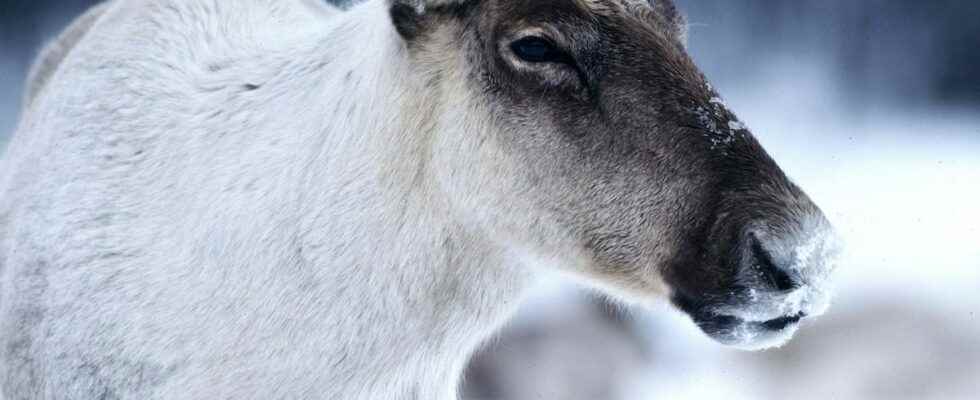The caribou protection strategy, scheduled for next June, has not yet been published, but experts predict that the Quebec forest industry will accentuate the decline of the herds.
• Read also: Caribou are everywhere at COP15
• Read also: Caribou protection: no progress for Pessamit at COP15
The latest statistics released this week showed that the Gaspésie caribou population has shrunk by nearly 80% over the past 15 years. The herd would only number 33 animals.
The decline is also continuing in Nord-du-Québec and on the North Shore, except in the Caniapiscau sector where the moose population is increasing.
Photo Katia Bussière
In the Gaspésie, Nord-du-Québec and Côte-Nord regions, caribou populations continue to decline. In the photo, caribou at the top of Mont-Albert, in the Gaspésie National Park.
The Ministry of the Environment, the Fight against Climate Change, Wildlife and Parks (MELCCFP) plans to deliver its strategy for woodland and mountain caribou in the summer of 2023.
Populations of these species will continue to be threatened, however, according to a ministry retiree who has spent 27 years studying the iconic animal.
Ecologically sustainable operation
“The Ministry of the Environment, especially the current minister, does not have the backbone to go to the Council of Ministers to say that nature must also be protected. I believe there will be protected areas, but probably they will be at the top of the commercial forest line. It is the economic activity that takes precedence over the others,” says Serge Couturier.
According to the independent consultant, the conservation of woodland caribou and Gaspésie caribou is possible only by implementing ecologically sustainable forest exploitation for the first time in Quebec. This is also the title of his dissertation submitted in May 2022.
“I don’t expect anything good from the strategy. With 30 or 34 caribou remaining in the Gaspé, there are not many possibilities left to save them. The cause of the decline is logging. The caribou don’t wait for political announcements to have problems,” says the specialist ironically.
Muscular actions claimed
For his part, Daniel Fortin, researcher at Laval University, also calls for more muscular actions. Recently, he commissioned a poll showing that two out of three people feel that the government is not taking enough steps to protect the herds.
“It is an emblematic species. If we can’t protect him, we have to wonder about others. If we protect a large area of undisturbed forest, imagine the number of species that we will protect at the same time,” adds the professor in the biology department.
In December, Quebec took advantage of the opening of COP15 in Montreal to announce an investment of $650 million to ensure the protection of 30% of its territory by 2030. Caribou assistance measures will come in a few month.
“The department is committed to unveiling a strategy and for the past few years we have had a more rigorous follow-up program. There are already interim measures. The upcoming document will be based on science,” said Carl Patenaude-Levasseur, director general of regional wildlife management coordination at the ministry.
— With the collaboration of Marianne White
NORTH OF QUEBEC – NOTTAWAY POPULATION
- 240 individuals from the Nottaway woodland caribou herd were counted in winter 2022
- 204 could be classified:
– 85 males
– 93 females
– 26 fawns - A total of 39 caribou groups were located and group sizes ranged from 1 to 21 individuals.
- The department estimates the population of woodland caribou in the Nottaway herd at 282 individuals, compared to 308 in 2016.
- The decline of this population is mainly related to the quality of its habitat.
NORTH SHORE – BUSTARD POPULATION
- 803 caribou were counted in the winter of 2022.
- These were divided into 67 groups of 1 to 85 individuals.
- The department estimates that the total number of caribou in the Bustard population would be between 803 and 1180 individuals.
- The ministry noted a decline in the areas southwest and north of the Manicouagan Reservoir compared to 2014. This poses a risk of local extinction of caribou groups.
- According to the inventory, the main disturbances to the habitat of this caribou population are logging roads, logging and clearing by fire.
GASPESIE – LOGAN SECTOR
- No caribou were observed.
- Since the 2010s, the caribou of the Logan sector have abandoned the mountain ranges in favor of a more forested habitat, which makes it more difficult to locate individuals by helicopter.
GASPESIE – ALBERT SECTOR
- 7 caribou were counted in the fall of 2021:
– 3 males
– 3 females
– 1 fawn - The total number of caribou in the Albert sector has continued to decline since 2010 and in 2021 fell below the threshold of 10 individuals.
- Recruitment is a concern in this sector where only one calf has been observed.
- The Gaspésie mountain caribou was designated a threatened species in 2009 in Quebec.
GASPESIE – MCGERRIGLE SECTOR
- 26 caribou were counted in the fall of 2021:
– 10 males
– 12 females
– 4 fawns - Since the last inventory, the number of adult caribou has increased while the number of calves has decreased.
- According to the ministry, the number of caribou in this sector seems stable, even slightly increasing, after an increased decline observed from 2013 to 2016.

